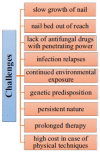Novel Drug Delivery Strategies for the Treatment of Onychomycosis
- PMID: 31092174
- PMCID: PMC6691844
- DOI: 10.2174/2211738507666190228104031
Novel Drug Delivery Strategies for the Treatment of Onychomycosis
Abstract
Onychomycosis accounts for 50% of all nail disease cases and is commonly caused by dermatophytes. It was primarily considered a cosmetic problem but has been garnering attention lately due to its persistent nature and difficult treatment with relapses. With prolonged treatment duration and high cost involved in treating onychomycosis, several attempts have been made in overcoming the rigid nail barrier. The conventional treatment of onychomycosis involves oral and topical therapy. The oral antifungal agents though quite effective, are hepato-toxic and cause drug-drug interactions. Topical therapy is more patient compliant being devoid of such adverse effects but it suffers from another setback of improper nail penetration. Amorolfine and ciclopirox nail lacquers are popular market products. Since decades, efforts have been made to enhance topical delivery for efficiently treating onychomycosis. Mechanical, physical and chemical methods have been employed. Despite all the attempts made, the nail delivery issues are far from being solved. Recently, the focus has shifted to novel drug delivery systems like nanoparticles, microemulsions, polymeric films and nail lacquers for enhanced drug permeation and localized therapy. The research around the world is exploring their potential as effective treatment options. This review intends to further explore the novel delivery strategies to treat a persistent fungal infection like onychomycosis.
Keywords: Nail barrier; drug delivery; nanoparticles; novel strategies; onychomycosis; persistent infection..
Copyright© Bentham Science Publishers; For any queries, please email at epub@benthamscience.net.
Figures
References
-
- Thapa R.K., Choi J.Y., Go T.G., et al. Development of ciclopirox nail lacquer with enhanced permeation and retention. Arch. Pharm. Res. 2016;39(7):953–959. - PubMed
-
- Adekhandi S., Pal S., Sharma N., Juyal D. Incidence and epidemiology of onychomycosis in patients visiting a tertiary care hospital in India. Cutis. 2015;95:E20–E5. - PubMed
-
- Kushwaha A., Murthy R.N., Murthy S.N., Elkeeb R., Hui X., Maibach H.I. Emerging therapies for the treatment of ungual onychomycosis. Drug Dev. Ind. Pharm. 2015;41(10):1–7. - PubMed
Publication types
MeSH terms
Substances
LinkOut - more resources
Full Text Sources
Other Literature Sources
Medical



